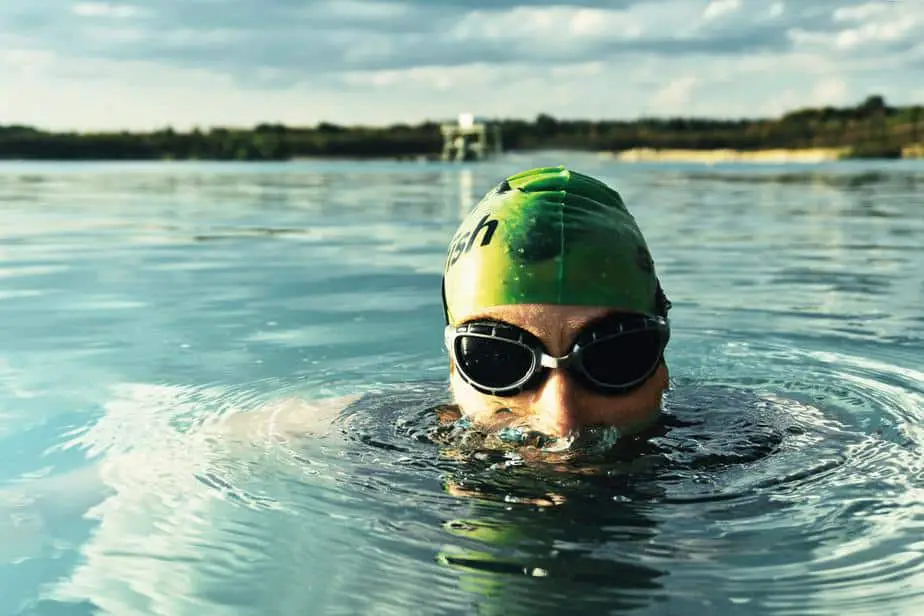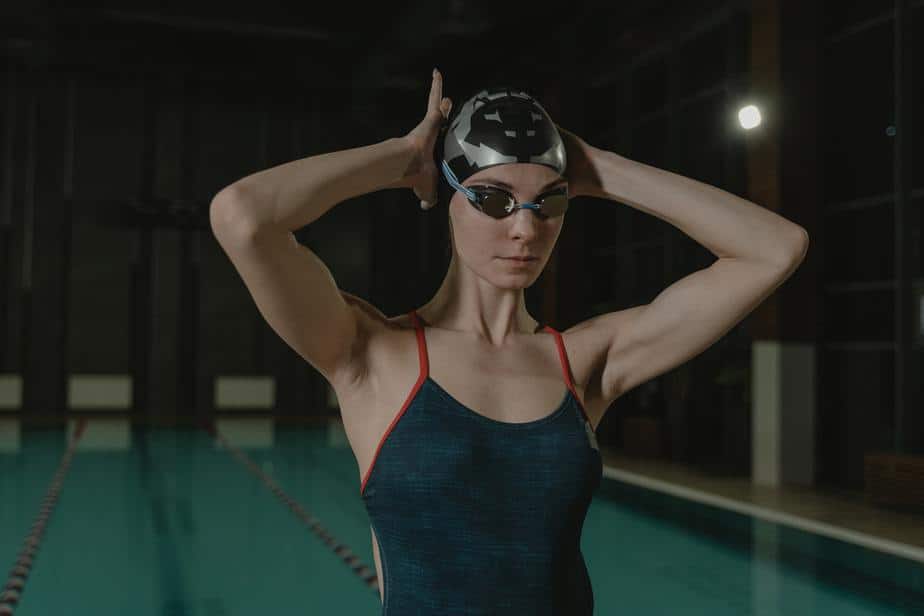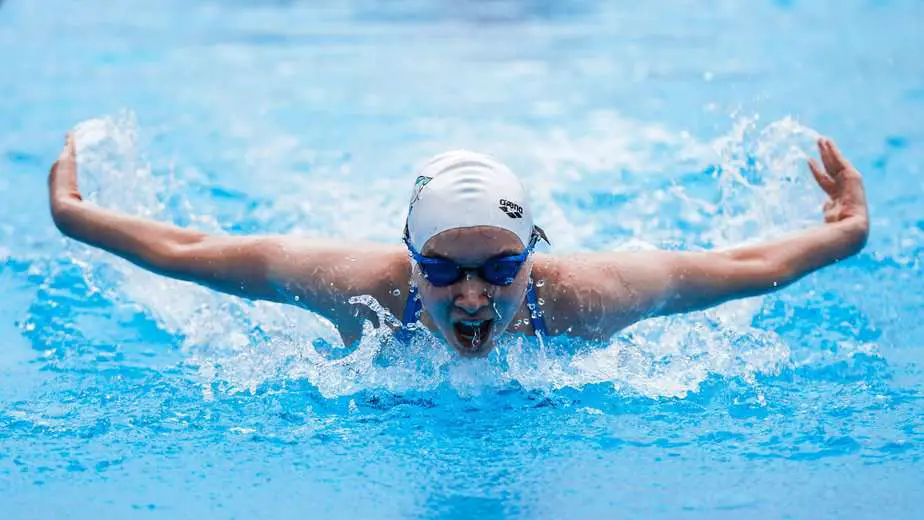There is a big misconception that swimmers wear swim caps to keep their hair dry. First off, swim caps do not keep your hair dry, even though some caps do a good job of doing so. Water will seep into the cap and get your hair wet.
If swimming caps are not waterproof, then why do swimmers wear them? The purpose of swim caps is to make you more streamlined underwater by keeping your hair packed down. Swim caps can limit your hair’s contact with water which limits the amount of chlorine your hair is exposed to, limiting damage. Swim caps also keep hair from falling into the pool which could clog the filters or end up in someone’s mouth. Lastly, you can wear swim caps for warmth, and no, it does not need to keep you dry to keep you warm.
People who really want to keep their hair dry while swimming should consider wearing two swim caps. This should give you a tight fit that can keep most of the water out (but isn’t guaranteed).
In this article, we will discuss the underlying reasons why swim caps are not waterproof, what their intended function is, and we will provide tips to keep hair wetness to a minimum if you really want to keep your hair dry.
What swim caps are actually designed to do

At its core, the reason why swim caps don’t keep your hair dry is because it does not form a watertight seal around your hair, despite how tight one can fit on your head. Being watertight is not a priority and it’s not a design flaw.
Rather, a swim cap’s purpose is to keep your hair packed down, which streamlines your head shape. The end result is a more hydrodynamic shape that can move through the water just a bit faster than if you didn’t wear the cap and your hair could freely float.
Speaking of hair floating in the water, the swim cap also ensures that hair does not get in your way when swimming. It also ensures that any hair that would have fallen off is caught in the cap instead of left floating in the pool or clogging up the pool filter.
There are many more practical reasons to wear a swim cap. For outdoor swimming, the water is colder, so you may want some extra warmth. Neoprene swim caps are excellent for keeping your head warm.
Also, if you’re swimming outdoors and you start encountering rough waters and need assistance, chances are your swim cap is a bright color that stands out, making you easier to spot and rescue.
As you can see, a swim cap’s primary purpose is for performance and practicality, not for hair aesthetics.
Heck, even when it comes to protecting your hair, swim caps are beneficial because they can limit the amount of water your hair is exposed to. A swim cap acts as a physical barrier between the water and your hair, and some parts of your hair may be able to stay dry if the fit is tight enough and the hair is packed down tightly.
How does water get inside a swim cap?
![]()
The reality is that it’s nearly impossible for something like a swim cap to keep your hair completely dry. Water seems to have a knack for passing through even the smallest points, such as a crack in the wall or pipe, no matter how tight the seal seems.
When you consider how simplistic a swim cap is – literally a piece of rubber that you just put on your head – then you will start to realize that it would be a miracle if a swim cap could keep your hair completely dry.
It doesn’t help that some shady companies have marketed their swim caps as “waterproof”. Sure, it’s waterproof in the sense that water cannot penetrate through the material. But it doesn’t keep water out, which is what people interpret the marketing as, so buyers beware.
The water will still get inside a swim cap through various gaps that the swim cap does not fully seal. No one’s head size and shape is exactly the same, which makes it hard for you to judge how well a swim cap can keep water out of the hair.
Another factor to consider is that our skin naturally has creases and wrinkles. Add on the fact that some strands of hair are surely going to be in the way, and even the tinest gap can allow water to seep inside the swim cap.
You might think the solution is to get a tighter swim cap but not only will that not work, but it will feel uncomfortable to wear. You would literally need to fasten the cap to your skin to completely cover up all the leakage points.
As an aside, you probably don’t want to completely prohibit water from entering the cap anyways. We mentioned that swim caps can keep your head warm, and that’s even with water inside. Without water, your head would become disproportionately warmer than the rest of your body, to the point that it would be uncomfortable and distracting.
If swim caps don’t keep my hair dry, what can?

Unfortunately, there aren’t any options to keep your hair dry underwater short of wearing a full body atmospheric diving suit. Not even wearing a dive hood will do the trick.
The only way you can guarantee that your hair stays dry is if you just never submerge your head underwater in the first place. Swim caps and shower caps are effective at keeping your hair dry from water that splashes on them, but not if you fully submerge underwater.
If your goal is not necessarily to keep your hair dry, but to protect your hair from the damage saltwater and chlorinated water causes, then swim caps are still your best bet.
As mentioned, swim caps can limit how much water seeps inside. If you pre-soak your hair with freshwater, then your hair will be saturated with that already, and it will not absorb the saltwater or chlorinated water which can dry it out and damage it.
Also, if you really want to keep water out, you can try wearing two swim caps. The rationale is that if one swim cap can reduce water seepage, then two will be even more effective. In fact, this is what Olympic swimmers do anyway, but for different reasons.
The recommendation is that the first cap you wear is a Latex cap. Latex caps stick to the head better and are unlikely to slip off which would be disastrous if your goal is to keep your hair dry. For the second cap, look for one that is designed to cover your ears.
Many people tend to have hair around their ears or even past it, so covering the whole thing up makes it less likely that your ears or strands of hair are creating a gap. This also has the side benefit of keeping water out of your ears, reducing the chances of getting swimmer’s ear.
The downside of double capping is that it will feel more uncomfortable because now you have two tight swim caps on your head.
Parting words
To sum it up, swim caps are not waterproof in the sense that while water cannot penetrate through the swim cap material, they do NOT keep your hair dry. Water will find a way to get inside through various gaps, and that is totally fine from a performance perspective.
In a similar vein, swimsuits aren’t waterproof either because even though water can’t directly pass through the neoprene, it can still get in from the arm, leg, and neck openings.
If your goal is to protect your hair from chlorine’s damaging effects, you should still wear a swim cap. Swim caps will limit the amount of contact water has with your hair. We also recommend soaking your hair in freshwater first, and then thoroughly rinsing your hair afterwards. Wash your hair with chlorine shampoo to properly get rid of all of that harmful chlorine, and your hair should be spick and span afterwards.


